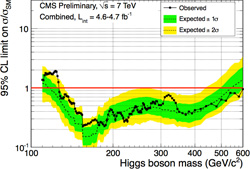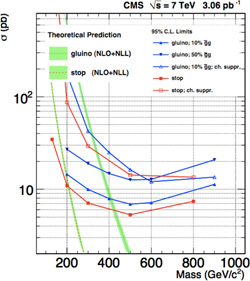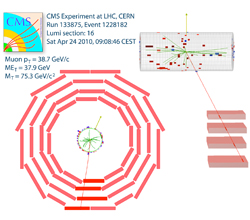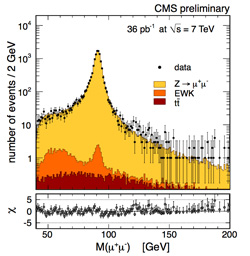Higgs search in H→ZZ→llqq
 We have been involved in the search for the Higgs boson in the decay into a pair of leptons and two jets from quark fragmentation. The identification of b quarks in the final state allows to reduce the background from Standard Model processes.
We have been involved in the search for the Higgs boson in the decay into a pair of leptons and two jets from quark fragmentation. The identification of b quarks in the final state allows to reduce the background from Standard Model processes.
We are now involved in the measurement of the Higgs boson properties. The decay channel with 4 leptons in the final state is very well suited for measuring the eigenvalues of parity and charge conjugation of the newly discovered resonance.
The signal selection strategy is based on the reconstruction and identification of the 4 final state leptons (4e, 4μ and 2e2μ), whose transverse momentum spectra vary between 5 and 200 GeV/c, where one of them has always low momentum (pT<10 GeV/c).
The data analysis and the determination of the new signal properties are carried out with appropriate statistical techniques for hypothesis testing, developed by building "likelihood" functions for the modeling of complex statistical fluctuations and of systematic uncertainties related to the experimental apparatus and background estimation. The Higgs boson is predicted to be a scalar particle with positive eigenvalues of parity and charge conjugation (JPC = 0++) and these parameters can be extracted separately from angular variables in both production and decay processes.
 Heavy stable (or quasi-stable) charged particles (HSCPs) appear in various extensions of the standard model. If the lifetime of an HSCP produced at the Large Hadron Collider (LHC) is longer than a few nanoseconds, the particle will travel over distances that are comparable or larger than the size of a typical particle detector like the CMS experiment.
Heavy stable (or quasi-stable) charged particles (HSCPs) appear in various extensions of the standard model. If the lifetime of an HSCP produced at the Large Hadron Collider (LHC) is longer than a few nanoseconds, the particle will travel over distances that are comparable or larger than the size of a typical particle detector like the CMS experiment. The Vector Boson Task Force (VBTF) has been appointed with the task of editing the first W and Z electroweak papers for LHC collisions. The first W and Z candidate have been found and analyzed.
The Vector Boson Task Force (VBTF) has been appointed with the task of editing the first W and Z electroweak papers for LHC collisions. The first W and Z candidate have been found and analyzed.
 Standard Model electroweak processes are the first studies to be performed at the LHC. We developed an analysis strategy to measure the inclusive production of the Z boson decaying into muon pairs with the very first LHC data at CMS. We will analyze the very first collisions data as soon as produced by the LHC.
Standard Model electroweak processes are the first studies to be performed at the LHC. We developed an analysis strategy to measure the inclusive production of the Z boson decaying into muon pairs with the very first LHC data at CMS. We will analyze the very first collisions data as soon as produced by the LHC.